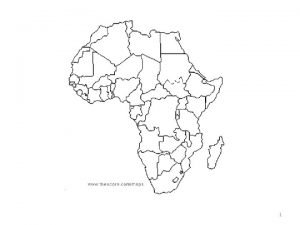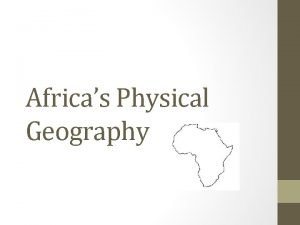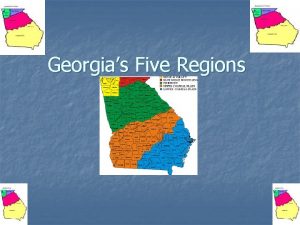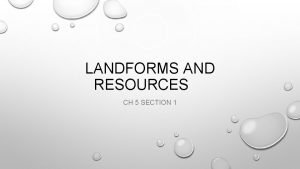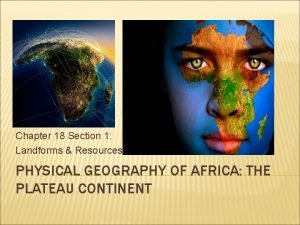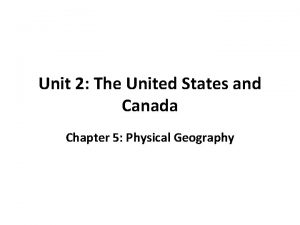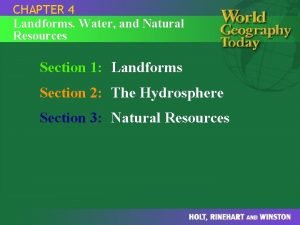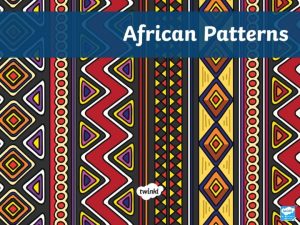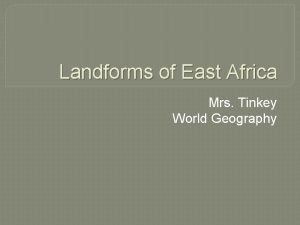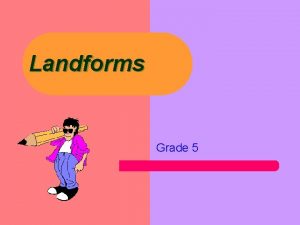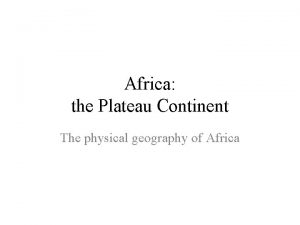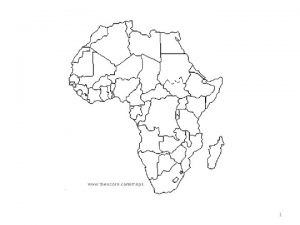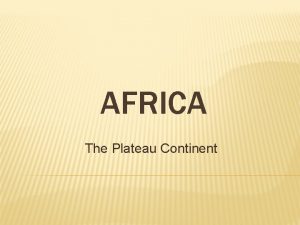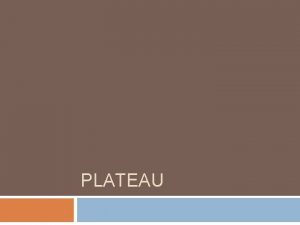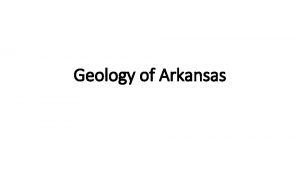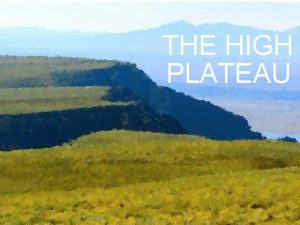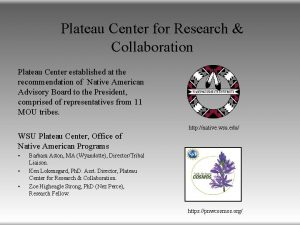The Plateau Continent Africa Landforms and Resources Shape

















- Slides: 17

The Plateau Continent Africa

Landforms and Resources • Shape and landforms are result of location in Pangea. – Other continents moved a great amount while present day Africa moved very little

True size of Africa

Vast Plateau • Majority of land lies on a plateau that stretches across the continent. – The majority of land is 1000 ft. above sea level – Basins: depressions in the ground – Nile River: world’s longest river, 4, 000 mi. long, flows N to Egypt Med Nile

Victoria Falls: One of the 7 Wonders of the World

Distinctive African Landforms • Rift Valleys: continental plates pull apart, form huge cracks, land sinks – Stretch 4, 000 mi. – Lakes form at the bottom • Mount Kenya and Mount Kilimanjaro (Africa’s Highest Mount. ) are both volcanoes • Escarpment: steep slope with a flat plateau

Resources • Minerals – Gold, platinum, chromium, cobalt, copper & diamonds – Because of colonialism, Africa hasn’t developed the infrastructure needed to make a profit Diamond Miners

• Oil – Libya, Angola, Nigeria and Algeria are leading producers – American oil companies pay fee to Angola which turns and uses money to fund ongoing civil war.

Diversity of Resources • Coffee – Most profitable after oil • Lumber • Agriculture – Single most important econ. activity – 60% of Africans earn their living in farming

Climate and Vegetation • Warm Continent • Sahara: largest desert in world. –Temp. H: 136. 4° (day), below freezing at night • Aquifers: underground stores of H²O. Known as an oasis when they reach surface • Tropical weather all year long – 90% of land lies between tropic of Cancer and tropic of Capricorn Sahara

Sunshine and Rainfall • Rain forest receives most rain (on or near Equator) • W coast receives a great deal • Moderate area (N & S tips) only receives rain in winter

Grassy Continent • Tropical Grasslands cover most of Africa – Serengeti Plain: grassland in N. Tanzania – Perfect for animals to graze

Serengeti

Rain Forest – Sits along Equator area of Congo basin – Wide variety of plant & animals • Most live in the canopy (near the tops of the trees) – Farmers using slash and burn have cut down ½ already, now endangered

Human Environment Interaction • Nigeria – Sixth leading oil producer, most shipped to U. S. – Oil spills (4, 000 in 40 yrs) • Oil pipeline explosions, sabotage by rebels • Fires lead to acid rain

Desertification of Sahel • Sahel: shore of the desert – Desertification: expansion of dry conditions into moist areas that are near desert • Normal, natural process that is sped up because of grazing • Causes include: overgrazing, farming, pop. increase

Controlling the Nile • 1 st Aswan Dam completed in 1902 • Aswan High Dam – – – 4 miles up river form 1 st Dam Creates Lake Nasser (artificial), Egypt shares with Sudan Increased farmable land by 50% Natural renewal of silt (sediment), which occurs during floods, gone Expensive fertilizers now used Mosquitoes increased
 Plateaus in africa and where they are found
Plateaus in africa and where they are found Chapter 18 the plateau continent
Chapter 18 the plateau continent The plateau continent
The plateau continent High plains landforms
High plains landforms Continental continental convergent boundary
Continental continental convergent boundary Divergent vs convergent boundaries
Divergent vs convergent boundaries Coastal plains attractions
Coastal plains attractions Chapter 24 section 1 landforms and resources
Chapter 24 section 1 landforms and resources Landforms in the southwest
Landforms in the southwest Chapter 5 section 1 landforms and resources
Chapter 5 section 1 landforms and resources Chapter 27 section 1 landforms and resources
Chapter 27 section 1 landforms and resources Major landforms in russia
Major landforms in russia Chapter 18 section 1 landforms and resources
Chapter 18 section 1 landforms and resources Natural resources in the canadian shield
Natural resources in the canadian shield Unit 2 the united states and canada worksheet answers
Unit 2 the united states and canada worksheet answers Natural resources from landforms
Natural resources from landforms Africa is the second largest continent
Africa is the second largest continent Great rift valley on map
Great rift valley on map
